Cloud Computing Assignment 1: BTEC Level 5 HND Diploma in Computing
VerifiedAdded on 2021/09/27
|39
|13651
|1383
Report
AI Summary
This assignment, submitted by a student, provides a comprehensive analysis of cloud computing fundamentals, architectures, deployment models, and service models. The report addresses a scenario involving ATN, a Vietnamese toy company, and proposes cloud computing solutions to improve data management and real-time stock information. The assignment covers the evolution of cloud computing, its benefits, and different service models such as SaaS, PaaS, and IaaS. It defines an appropriate deployment model, compares service models, and justifies the selection of tools for a cloud computing solution. The document includes an architectural design, detailed design considerations, and real-world examples of cloud deployment models. The student explores various tools like AWS CloudFormation, Kubernetes, and others to realize a cloud computing solution, concluding with a summary of the findings and references.
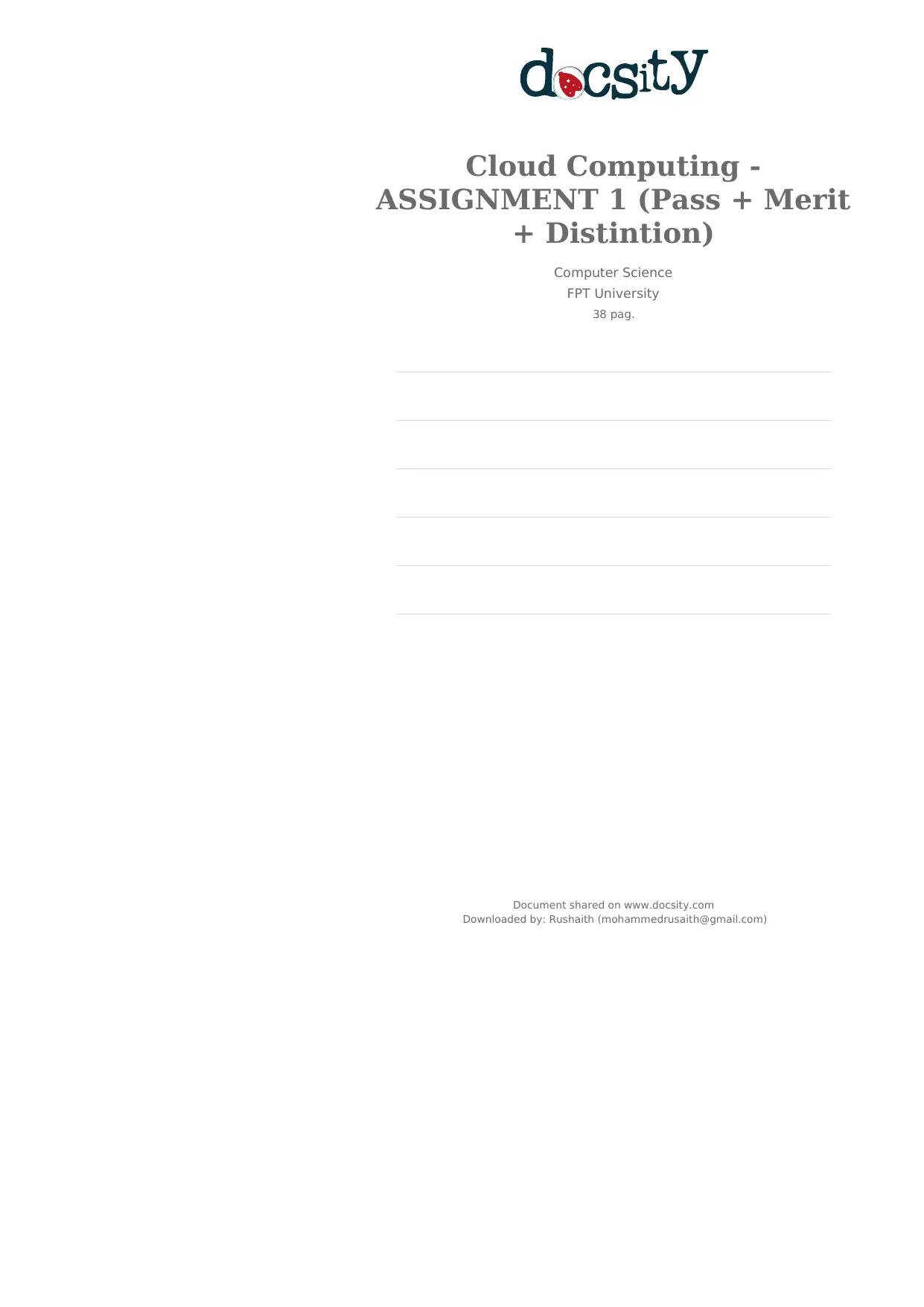
Cloud Computing -
ASSIGNMENT 1 (Pass + Merit
+ Distintion)
Computer Science
FPT University
38 pag.
Document shared on www.docsity.com
Downloaded by: Rushaith (mohammedrusaith@gmail.com)
ASSIGNMENT 1 (Pass + Merit
+ Distintion)
Computer Science
FPT University
38 pag.
Document shared on www.docsity.com
Downloaded by: Rushaith (mohammedrusaith@gmail.com)
Paraphrase This Document
Need a fresh take? Get an instant paraphrase of this document with our AI Paraphraser
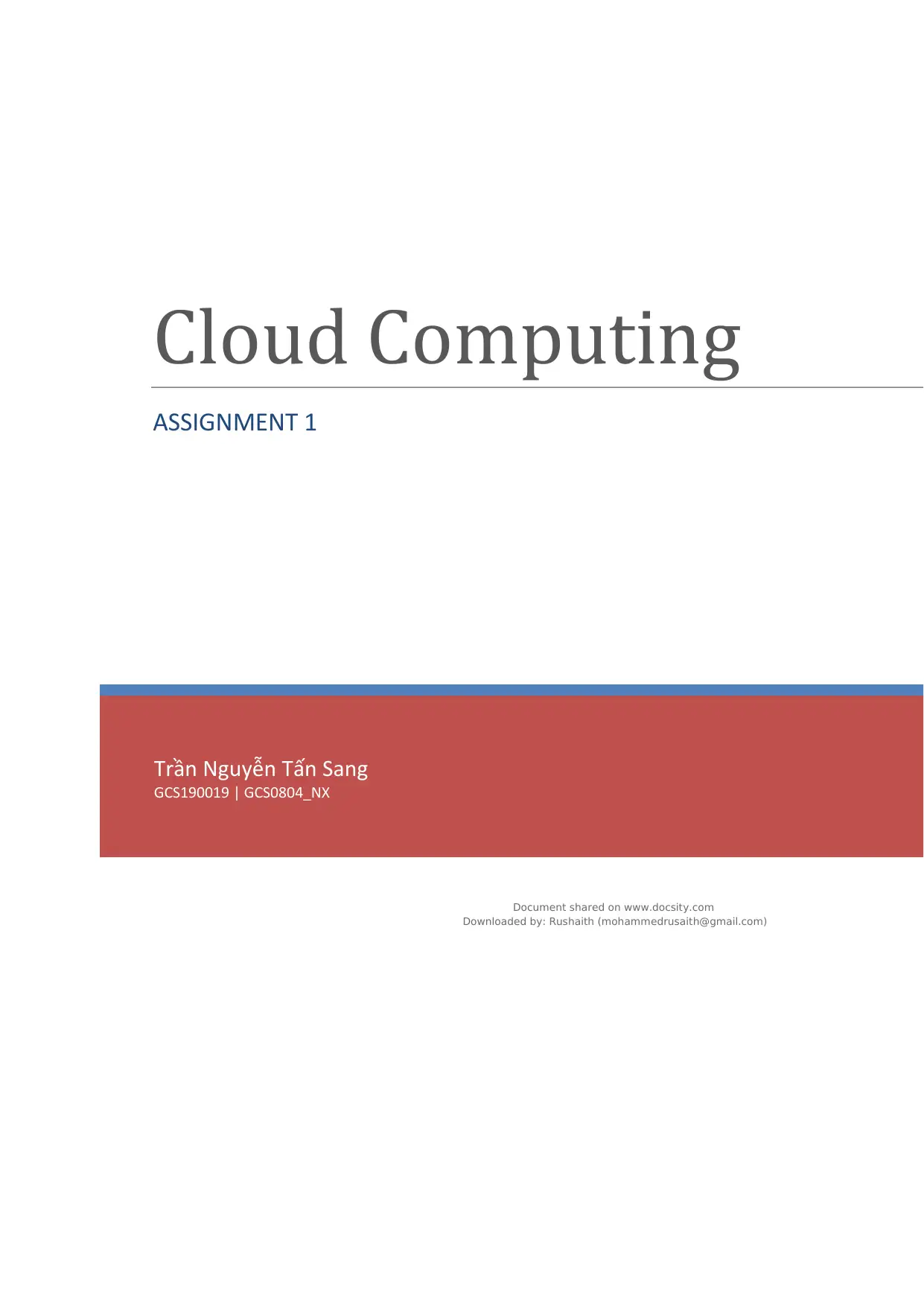
Trần Nguyễn Tấn Sang
GCS190019 | GCS0804_NX
Cloud Computing
ASSIGNMENT 1
Document shared on www.docsity.com
Downloaded by: Rushaith (mohammedrusaith@gmail.com)
GCS190019 | GCS0804_NX
Cloud Computing
ASSIGNMENT 1
Document shared on www.docsity.com
Downloaded by: Rushaith (mohammedrusaith@gmail.com)
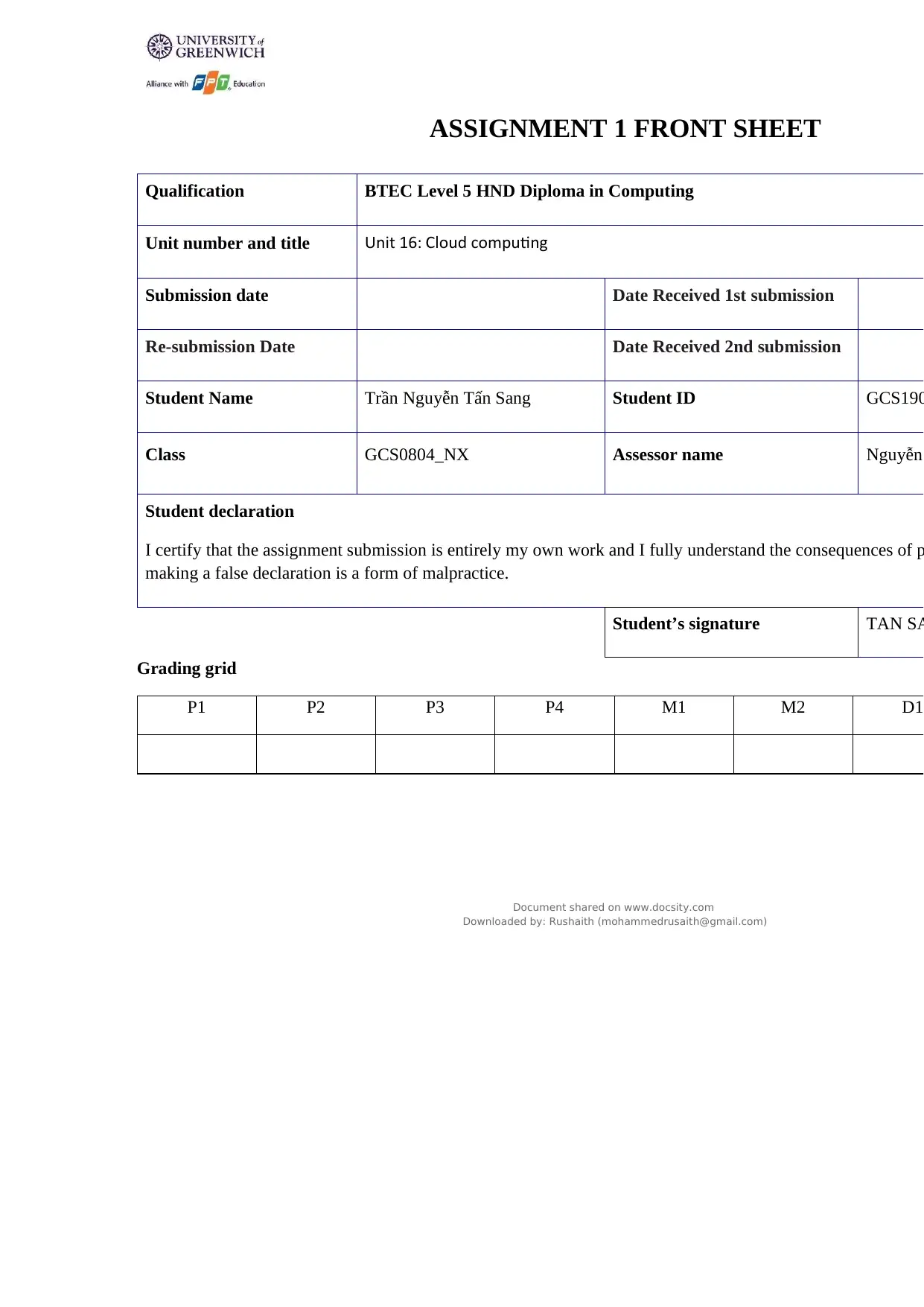
ASSIGNMENT 1 FRONT SHEET
Qualification BTEC Level 5 HND Diploma in Computing
Unit number and title Unit 16: Cloud computing
Submission date Date Received 1st submission
Re-submission Date Date Received 2nd submission
Student Name Trần Nguyễn Tấn Sang Student ID GCS190
Class GCS0804_NX Assessor name Nguyễn
Student declaration
I certify that the assignment submission is entirely my own work and I fully understand the consequences of p
making a false declaration is a form of malpractice.
Student’s signature TAN SA
Grading grid
P1 P2 P3 P4 M1 M2 D1
Document shared on www.docsity.com
Downloaded by: Rushaith (mohammedrusaith@gmail.com)
Qualification BTEC Level 5 HND Diploma in Computing
Unit number and title Unit 16: Cloud computing
Submission date Date Received 1st submission
Re-submission Date Date Received 2nd submission
Student Name Trần Nguyễn Tấn Sang Student ID GCS190
Class GCS0804_NX Assessor name Nguyễn
Student declaration
I certify that the assignment submission is entirely my own work and I fully understand the consequences of p
making a false declaration is a form of malpractice.
Student’s signature TAN SA
Grading grid
P1 P2 P3 P4 M1 M2 D1
Document shared on www.docsity.com
Downloaded by: Rushaith (mohammedrusaith@gmail.com)
⊘ This is a preview!⊘
Do you want full access?
Subscribe today to unlock all pages.

Trusted by 1+ million students worldwide
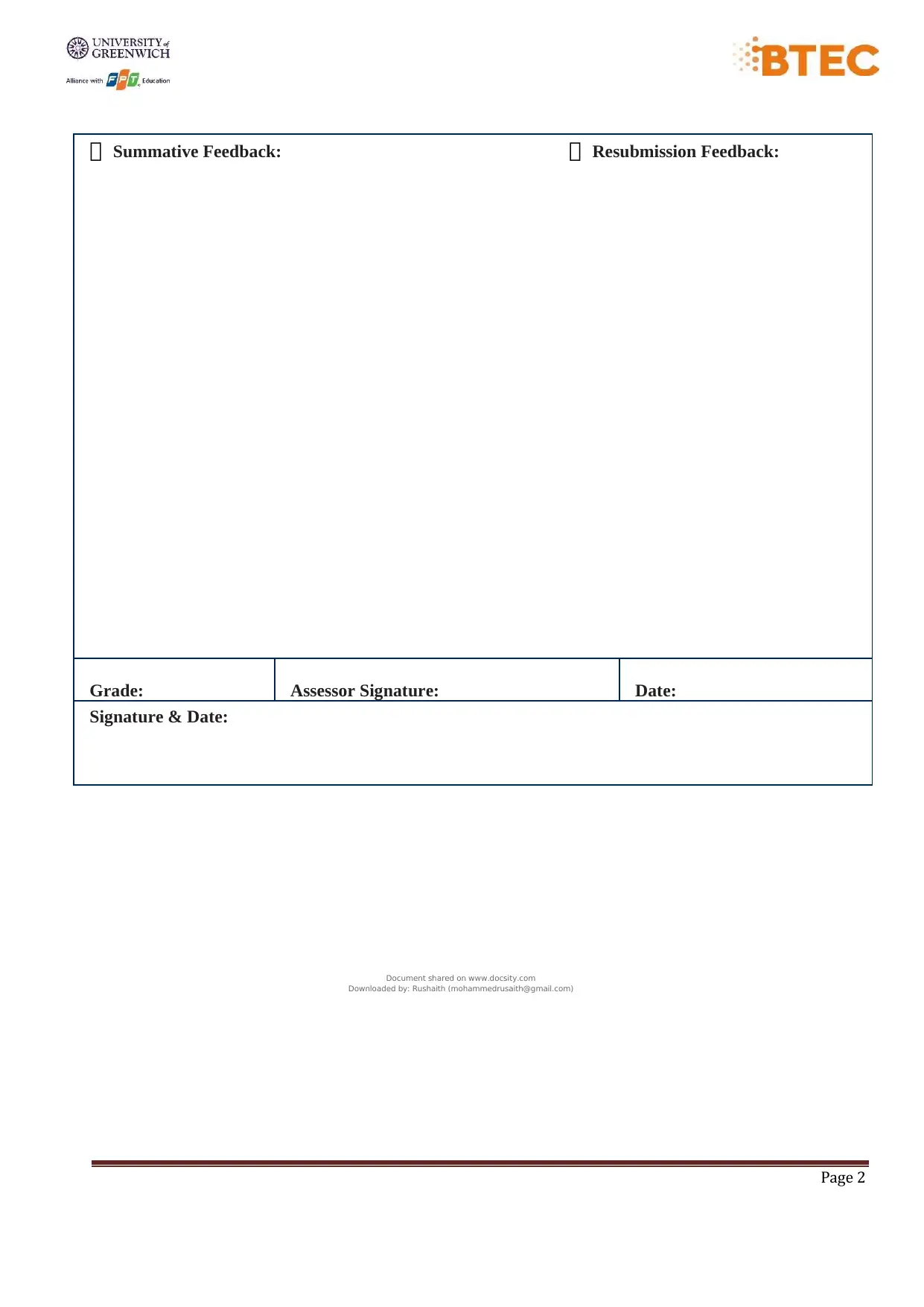
Page 2
Summative Feedback: Resubmission Feedback:
Grade: Assessor Signature: Date:
Signature & Date:
Document shared on www.docsity.com
Downloaded by: Rushaith (mohammedrusaith@gmail.com)
Summative Feedback: Resubmission Feedback:
Grade: Assessor Signature: Date:
Signature & Date:
Document shared on www.docsity.com
Downloaded by: Rushaith (mohammedrusaith@gmail.com)
Paraphrase This Document
Need a fresh take? Get an instant paraphrase of this document with our AI Paraphraser
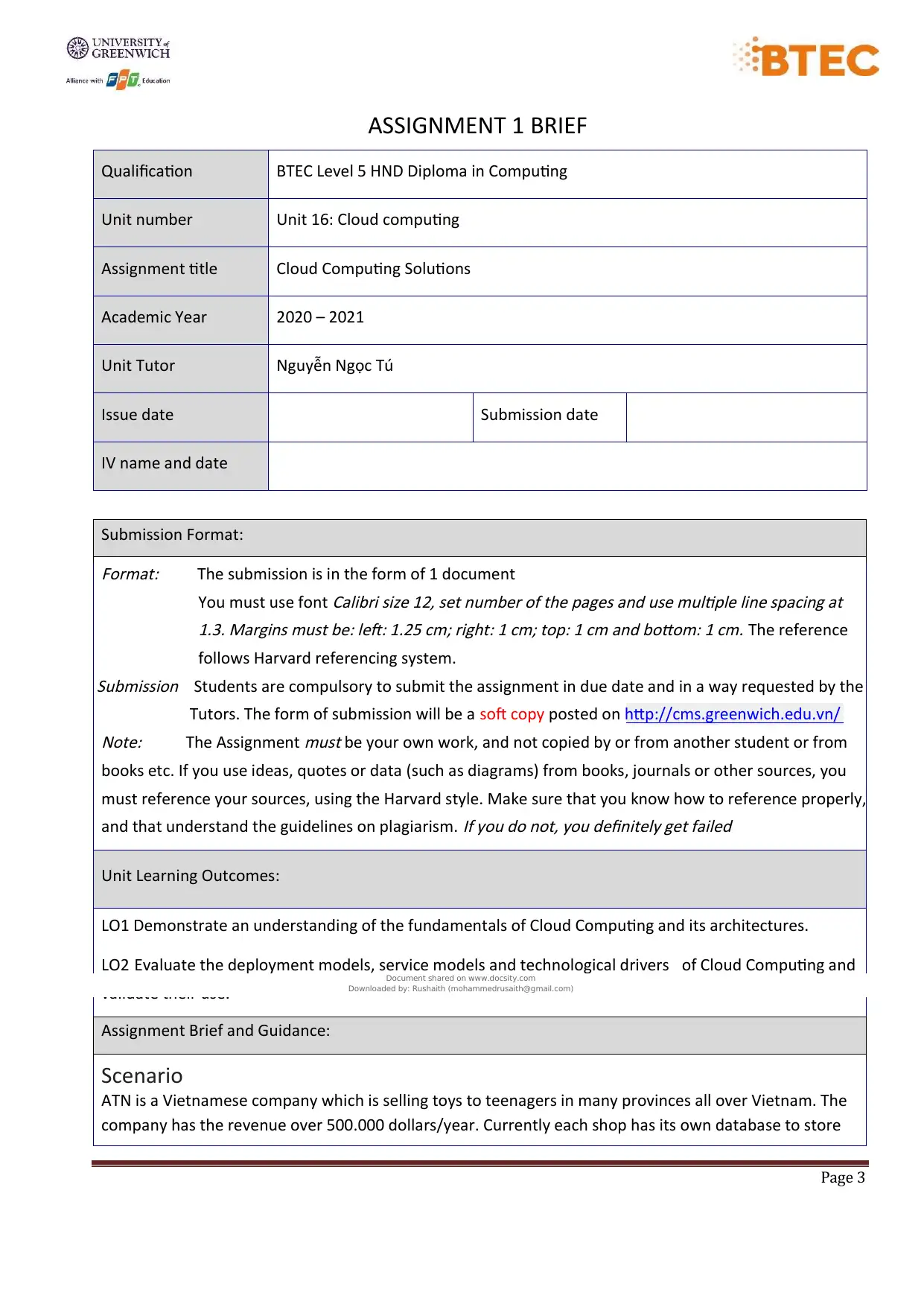
Page 3
ASSIGNMENT 1 BRIEF
Qualification BTEC Level 5 HND Diploma in Computing
Unit number Unit 16: Cloud computing
Assignment title Cloud Computing Solutions
Academic Year 2020 – 2021
Unit Tutor Nguyễn Ngọc Tú
Issue date Submission date
IV name and date
Submission Format:
Format: The submission is in the form of 1 document
You must use font
Calibri size 12, set number of the pages and use multiple line spacing at
1.3. Margins must be: left: 1.25 cm; right: 1 cm; top: 1 cm and bottom: 1 cm. The reference
follows Harvard referencing system.Submission Students are compulsory to submit the assignment in due date and in a way requested by the
Tutors. The form of submission will be a soft copy posted on http://cms.greenwich.edu.vn/Note: The Assignment
must be your own work, and not copied by or from another student or from
books etc. If you use ideas, quotes or data (such as diagrams) from books, journals or other sources, you
must reference your sources, using the Harvard style. Make sure that you know how to reference properly,
and that understand the guidelines on plagiarism.
If you do not, you definitely get failed
Unit Learning Outcomes:
LO1 Demonstrate an understanding of the fundamentals of Cloud Computing and its architectures.
LO2 Evaluate the deployment models, service models and technological drivers of Cloud Computing and
validate their use.
Assignment Brief and Guidance:
Scenario
ATN is a Vietnamese company which is selling toys to teenagers in many provinces all over Vietnam. The
company has the revenue over 500.000 dollars/year. Currently each shop has its own database to store
Document shared on www.docsity.com
Downloaded by: Rushaith (mohammedrusaith@gmail.com)
ASSIGNMENT 1 BRIEF
Qualification BTEC Level 5 HND Diploma in Computing
Unit number Unit 16: Cloud computing
Assignment title Cloud Computing Solutions
Academic Year 2020 – 2021
Unit Tutor Nguyễn Ngọc Tú
Issue date Submission date
IV name and date
Submission Format:
Format: The submission is in the form of 1 document
You must use font
Calibri size 12, set number of the pages and use multiple line spacing at
1.3. Margins must be: left: 1.25 cm; right: 1 cm; top: 1 cm and bottom: 1 cm. The reference
follows Harvard referencing system.Submission Students are compulsory to submit the assignment in due date and in a way requested by the
Tutors. The form of submission will be a soft copy posted on http://cms.greenwich.edu.vn/Note: The Assignment
must be your own work, and not copied by or from another student or from
books etc. If you use ideas, quotes or data (such as diagrams) from books, journals or other sources, you
must reference your sources, using the Harvard style. Make sure that you know how to reference properly,
and that understand the guidelines on plagiarism.
If you do not, you definitely get failed
Unit Learning Outcomes:
LO1 Demonstrate an understanding of the fundamentals of Cloud Computing and its architectures.
LO2 Evaluate the deployment models, service models and technological drivers of Cloud Computing and
validate their use.
Assignment Brief and Guidance:
Scenario
ATN is a Vietnamese company which is selling toys to teenagers in many provinces all over Vietnam. The
company has the revenue over 500.000 dollars/year. Currently each shop has its own database to store
Document shared on www.docsity.com
Downloaded by: Rushaith (mohammedrusaith@gmail.com)
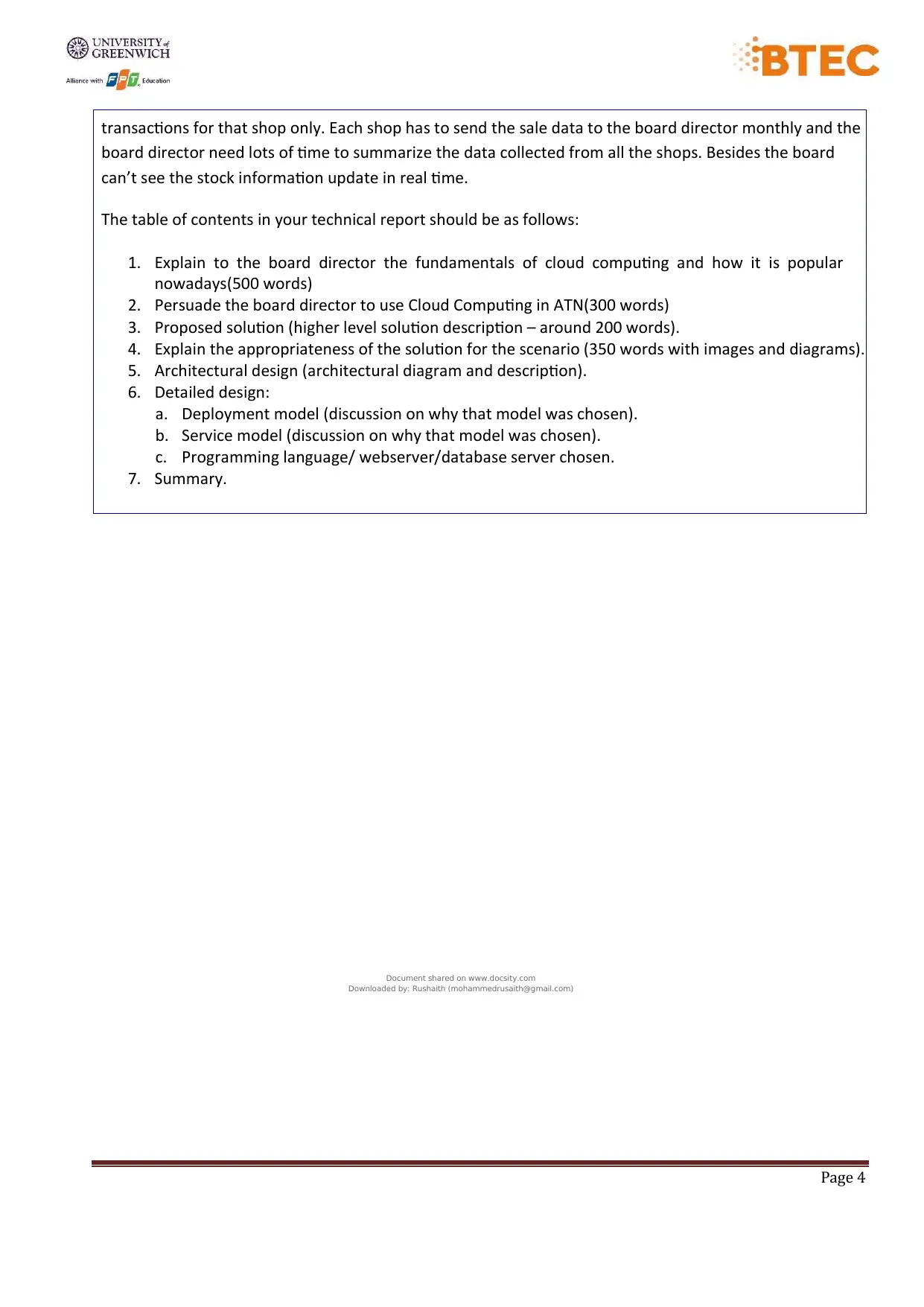
Page 4
transactions for that shop only. Each shop has to send the sale data to the board director monthly and the
board director need lots of time to summarize the data collected from all the shops. Besides the board
can’t see the stock information update in real time.
The table of contents in your technical report should be as follows:
1. Explain to the board director the fundamentals of cloud computing and how it is popular
nowadays(500 words)
2. Persuade the board director to use Cloud Computing in ATN(300 words)
3. Proposed solution (higher level solution description – around 200 words).
4. Explain the appropriateness of the solution for the scenario (350 words with images and diagrams).
5. Architectural design (architectural diagram and description).
6. Detailed design:
a. Deployment model (discussion on why that model was chosen).
b. Service model (discussion on why that model was chosen).
c. Programming language/ webserver/database server chosen.
7. Summary.
Document shared on www.docsity.com
Downloaded by: Rushaith (mohammedrusaith@gmail.com)
transactions for that shop only. Each shop has to send the sale data to the board director monthly and the
board director need lots of time to summarize the data collected from all the shops. Besides the board
can’t see the stock information update in real time.
The table of contents in your technical report should be as follows:
1. Explain to the board director the fundamentals of cloud computing and how it is popular
nowadays(500 words)
2. Persuade the board director to use Cloud Computing in ATN(300 words)
3. Proposed solution (higher level solution description – around 200 words).
4. Explain the appropriateness of the solution for the scenario (350 words with images and diagrams).
5. Architectural design (architectural diagram and description).
6. Detailed design:
a. Deployment model (discussion on why that model was chosen).
b. Service model (discussion on why that model was chosen).
c. Programming language/ webserver/database server chosen.
7. Summary.
Document shared on www.docsity.com
Downloaded by: Rushaith (mohammedrusaith@gmail.com)
⊘ This is a preview!⊘
Do you want full access?
Subscribe today to unlock all pages.

Trusted by 1+ million students worldwide
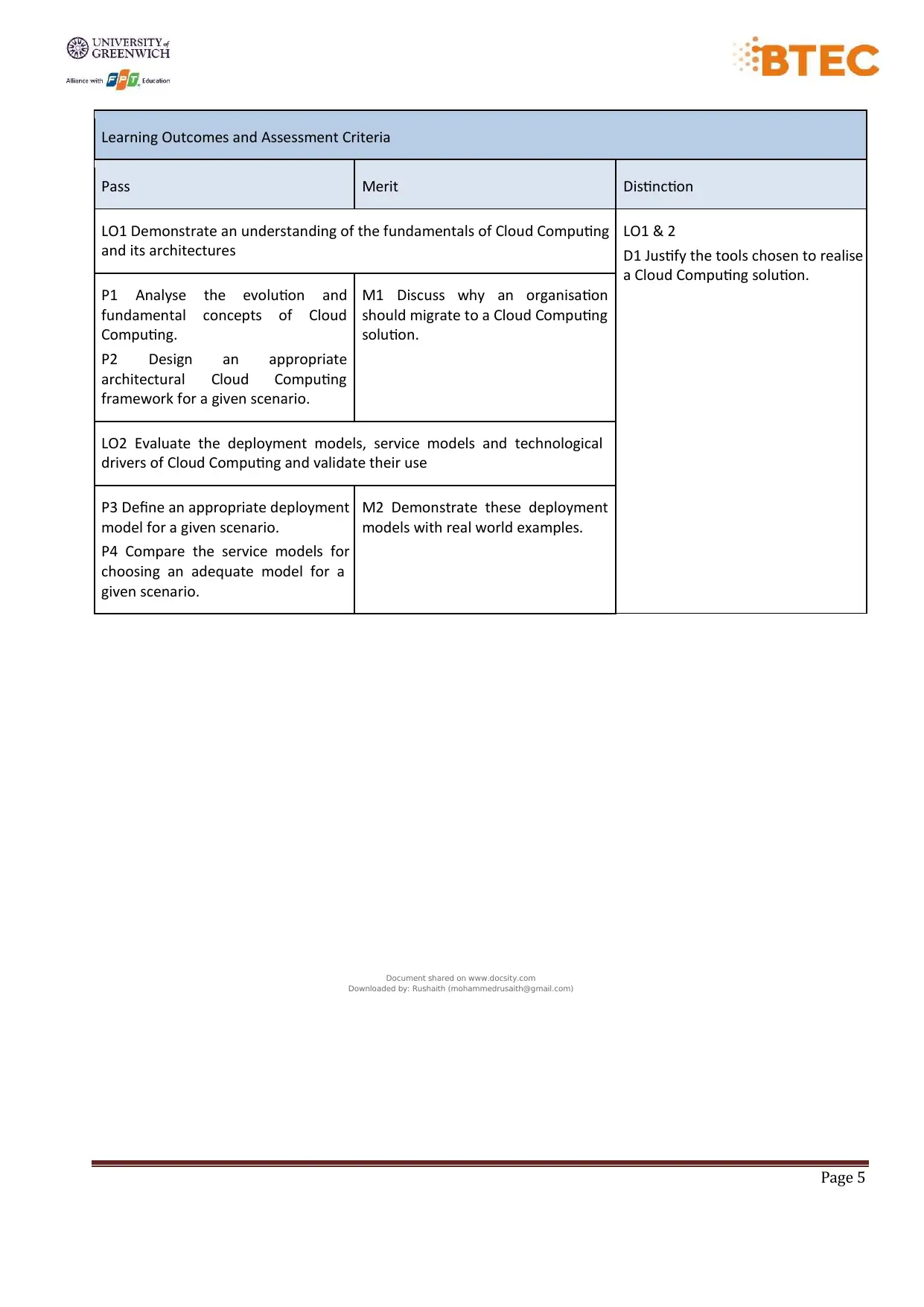
Page 5
Learning Outcomes and Assessment Criteria
Pass Merit Distinction
LO1 Demonstrate an understanding of the fundamentals of Cloud Computing
and its architectures
LO1 & 2
D1 Justify the tools chosen to realise
a Cloud Computing solution.
P1 Analyse the evolution and
fundamental concepts of Cloud
Computing.
P2 Design an appropriate
architectural Cloud Computing
framework for a given scenario.
M1 Discuss why an organisation
should migrate to a Cloud Computing
solution.
LO2 Evaluate the deployment models, service models and technological
drivers of Cloud Computing and validate their use
P3 Define an appropriate deployment
model for a given scenario.
P4 Compare the service models for
choosing an adequate model for a
given scenario.
M2 Demonstrate these deployment
models with real world examples.
Document shared on www.docsity.com
Downloaded by: Rushaith (mohammedrusaith@gmail.com)
Learning Outcomes and Assessment Criteria
Pass Merit Distinction
LO1 Demonstrate an understanding of the fundamentals of Cloud Computing
and its architectures
LO1 & 2
D1 Justify the tools chosen to realise
a Cloud Computing solution.
P1 Analyse the evolution and
fundamental concepts of Cloud
Computing.
P2 Design an appropriate
architectural Cloud Computing
framework for a given scenario.
M1 Discuss why an organisation
should migrate to a Cloud Computing
solution.
LO2 Evaluate the deployment models, service models and technological
drivers of Cloud Computing and validate their use
P3 Define an appropriate deployment
model for a given scenario.
P4 Compare the service models for
choosing an adequate model for a
given scenario.
M2 Demonstrate these deployment
models with real world examples.
Document shared on www.docsity.com
Downloaded by: Rushaith (mohammedrusaith@gmail.com)
Paraphrase This Document
Need a fresh take? Get an instant paraphrase of this document with our AI Paraphraser
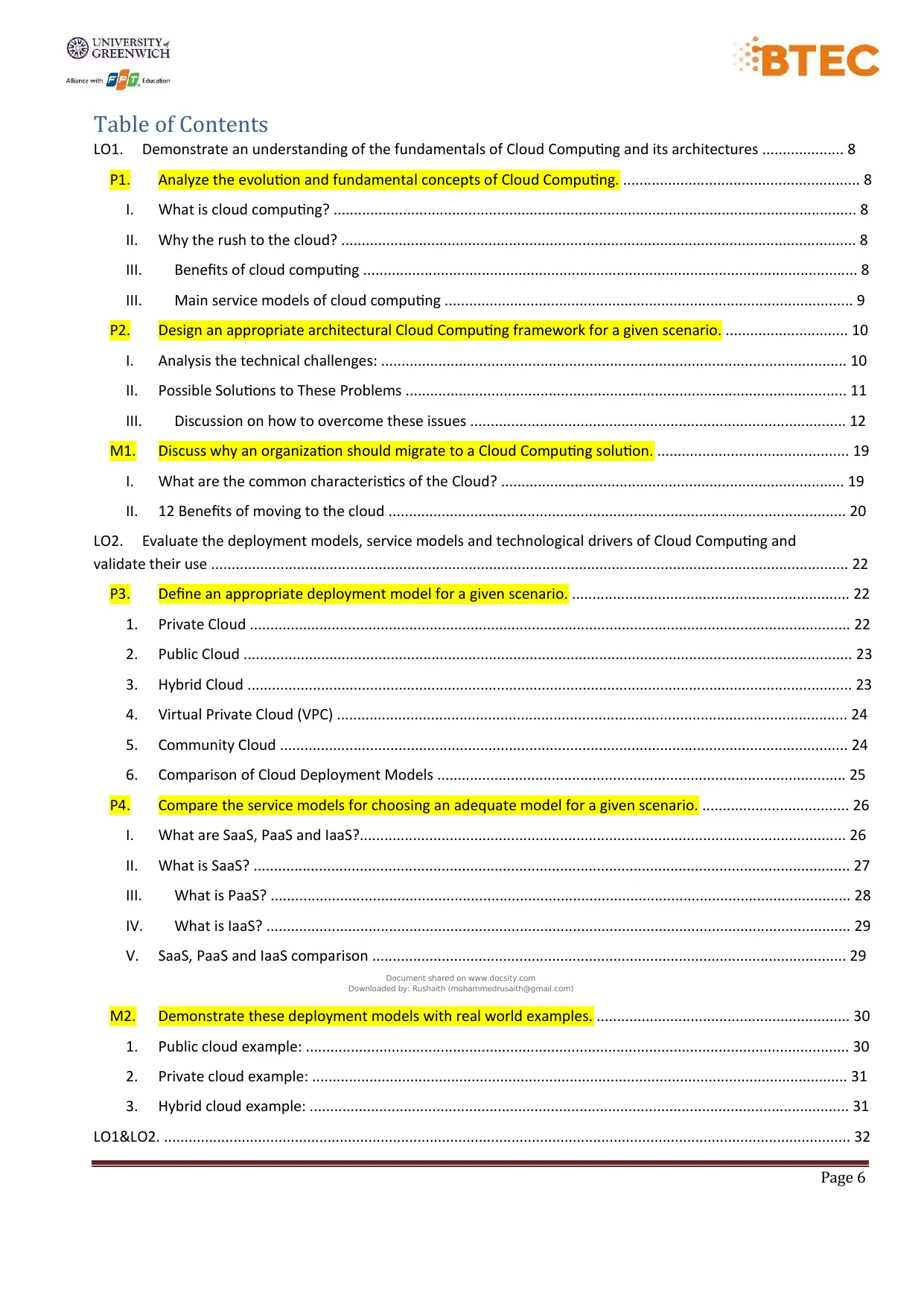
Page 6
Table of Contents
LO1. Demonstrate an understanding of the fundamentals of Cloud Computing and its architectures .................... 8
P1. Analyze the evolution and fundamental concepts of Cloud Computing. .......................................................... 8
I. What is cloud computing? ................................................................................................................................ 8
II. Why the rush to the cloud? .............................................................................................................................. 8
III. Benefits of cloud computing ......................................................................................................................... 8
III. Main service models of cloud computing .................................................................................................... 9
P2. Design an appropriate architectural Cloud Computing framework for a given scenario. .............................. 10
I. Analysis the technical challenges: .................................................................................................................. 10
II. Possible Solutions to These Problems ............................................................................................................ 11
III. Discussion on how to overcome these issues ............................................................................................ 12
M1. Discuss why an organization should migrate to a Cloud Computing solution. ............................................... 19
I. What are the common characteristics of the Cloud? .................................................................................... 19
II. 12 Benefits of moving to the cloud ................................................................................................................ 20
LO2. Evaluate the deployment models, service models and technological drivers of Cloud Computing and
validate their use ............................................................................................................................................................ 22
P3. Define an appropriate deployment model for a given scenario. .................................................................... 22
1. Private Cloud ................................................................................................................................................... 22
2. Public Cloud ..................................................................................................................................................... 23
3. Hybrid Cloud .................................................................................................................................................... 23
4. Virtual Private Cloud (VPC) ............................................................................................................................. 24
5. Community Cloud ........................................................................................................................................... 24
6. Comparison of Cloud Deployment Models .................................................................................................... 25
P4. Compare the service models for choosing an adequate model for a given scenario. .................................... 26
I. What are SaaS, PaaS and IaaS?....................................................................................................................... 26
II. What is SaaS? .................................................................................................................................................. 27
III. What is PaaS? .............................................................................................................................................. 28
IV. What is IaaS? ............................................................................................................................................... 29
V. SaaS, PaaS and IaaS comparison .................................................................................................................... 29
VI. IaaS vs PaaS vs SaaS: Which Cloud Service Is Suitable for Me?................................................................. 30
M2. Demonstrate these deployment models with real world examples. .............................................................. 30
1. Public cloud example: ..................................................................................................................................... 30
2. Private cloud example: ................................................................................................................................... 31
3. Hybrid cloud example: .................................................................................................................................... 31
LO1&LO2. ........................................................................................................................................................................ 32
Document shared on www.docsity.com
Downloaded by: Rushaith (mohammedrusaith@gmail.com)
Table of Contents
LO1. Demonstrate an understanding of the fundamentals of Cloud Computing and its architectures .................... 8
P1. Analyze the evolution and fundamental concepts of Cloud Computing. .......................................................... 8
I. What is cloud computing? ................................................................................................................................ 8
II. Why the rush to the cloud? .............................................................................................................................. 8
III. Benefits of cloud computing ......................................................................................................................... 8
III. Main service models of cloud computing .................................................................................................... 9
P2. Design an appropriate architectural Cloud Computing framework for a given scenario. .............................. 10
I. Analysis the technical challenges: .................................................................................................................. 10
II. Possible Solutions to These Problems ............................................................................................................ 11
III. Discussion on how to overcome these issues ............................................................................................ 12
M1. Discuss why an organization should migrate to a Cloud Computing solution. ............................................... 19
I. What are the common characteristics of the Cloud? .................................................................................... 19
II. 12 Benefits of moving to the cloud ................................................................................................................ 20
LO2. Evaluate the deployment models, service models and technological drivers of Cloud Computing and
validate their use ............................................................................................................................................................ 22
P3. Define an appropriate deployment model for a given scenario. .................................................................... 22
1. Private Cloud ................................................................................................................................................... 22
2. Public Cloud ..................................................................................................................................................... 23
3. Hybrid Cloud .................................................................................................................................................... 23
4. Virtual Private Cloud (VPC) ............................................................................................................................. 24
5. Community Cloud ........................................................................................................................................... 24
6. Comparison of Cloud Deployment Models .................................................................................................... 25
P4. Compare the service models for choosing an adequate model for a given scenario. .................................... 26
I. What are SaaS, PaaS and IaaS?....................................................................................................................... 26
II. What is SaaS? .................................................................................................................................................. 27
III. What is PaaS? .............................................................................................................................................. 28
IV. What is IaaS? ............................................................................................................................................... 29
V. SaaS, PaaS and IaaS comparison .................................................................................................................... 29
VI. IaaS vs PaaS vs SaaS: Which Cloud Service Is Suitable for Me?................................................................. 30
M2. Demonstrate these deployment models with real world examples. .............................................................. 30
1. Public cloud example: ..................................................................................................................................... 30
2. Private cloud example: ................................................................................................................................... 31
3. Hybrid cloud example: .................................................................................................................................... 31
LO1&LO2. ........................................................................................................................................................................ 32
Document shared on www.docsity.com
Downloaded by: Rushaith (mohammedrusaith@gmail.com)
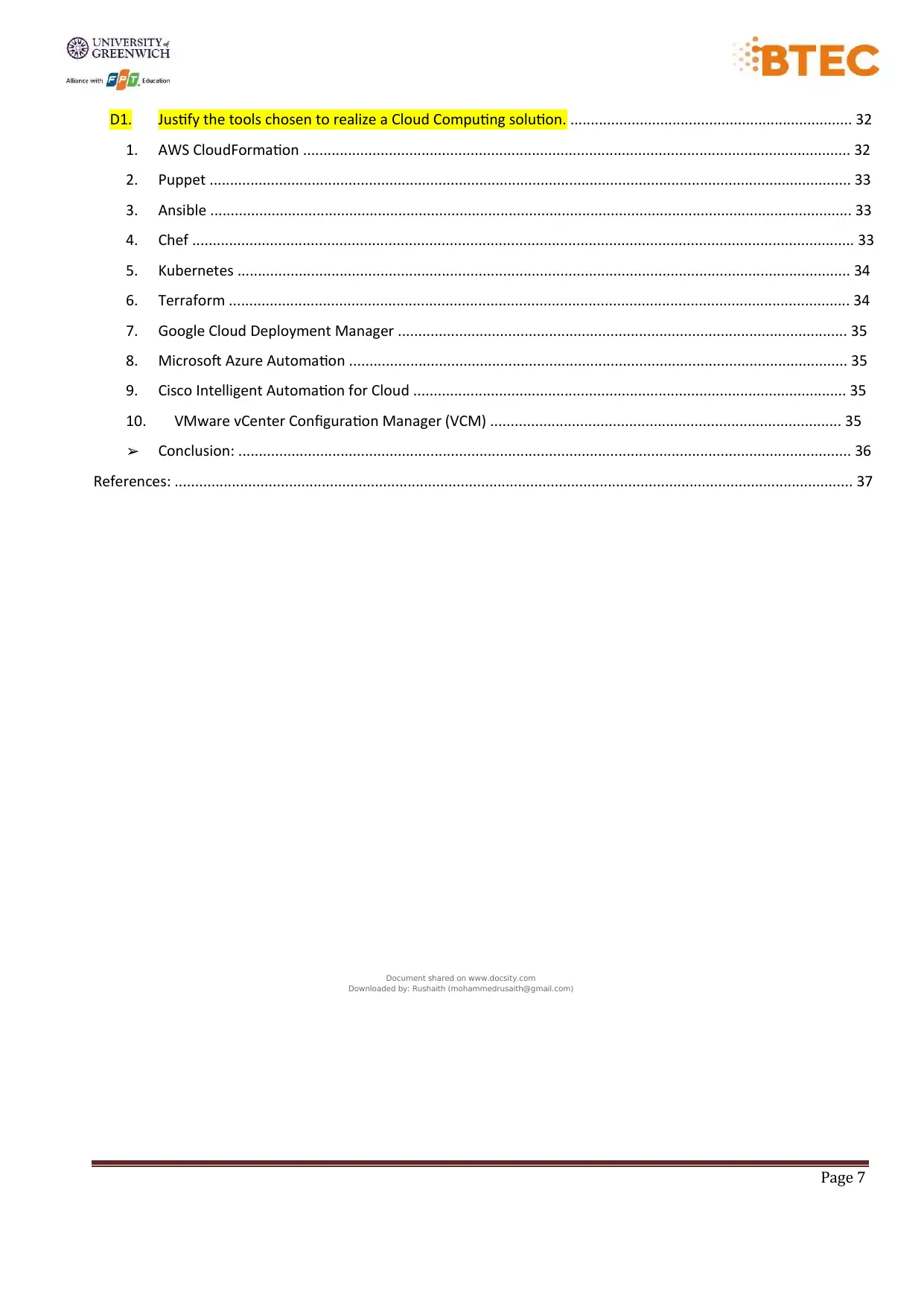
Page 7
D1. Justify the tools chosen to realize a Cloud Computing solution. ..................................................................... 32
1. AWS CloudFormation ...................................................................................................................................... 32
2. Puppet ............................................................................................................................................................. 33
3. Ansible ............................................................................................................................................................. 33
4. Chef .................................................................................................................................................................. 33
5. Kubernetes ...................................................................................................................................................... 34
6. Terraform ........................................................................................................................................................ 34
7. Google Cloud Deployment Manager .............................................................................................................. 35
8. Microsoft Azure Automation .......................................................................................................................... 35
9. Cisco Intelligent Automation for Cloud .......................................................................................................... 35
10. VMware vCenter Configuration Manager (VCM) ...................................................................................... 35
➢ Conclusion: ...................................................................................................................................................... 36
References: ...................................................................................................................................................................... 37
Document shared on www.docsity.com
Downloaded by: Rushaith (mohammedrusaith@gmail.com)
D1. Justify the tools chosen to realize a Cloud Computing solution. ..................................................................... 32
1. AWS CloudFormation ...................................................................................................................................... 32
2. Puppet ............................................................................................................................................................. 33
3. Ansible ............................................................................................................................................................. 33
4. Chef .................................................................................................................................................................. 33
5. Kubernetes ...................................................................................................................................................... 34
6. Terraform ........................................................................................................................................................ 34
7. Google Cloud Deployment Manager .............................................................................................................. 35
8. Microsoft Azure Automation .......................................................................................................................... 35
9. Cisco Intelligent Automation for Cloud .......................................................................................................... 35
10. VMware vCenter Configuration Manager (VCM) ...................................................................................... 35
➢ Conclusion: ...................................................................................................................................................... 36
References: ...................................................................................................................................................................... 37
Document shared on www.docsity.com
Downloaded by: Rushaith (mohammedrusaith@gmail.com)
⊘ This is a preview!⊘
Do you want full access?
Subscribe today to unlock all pages.

Trusted by 1+ million students worldwide
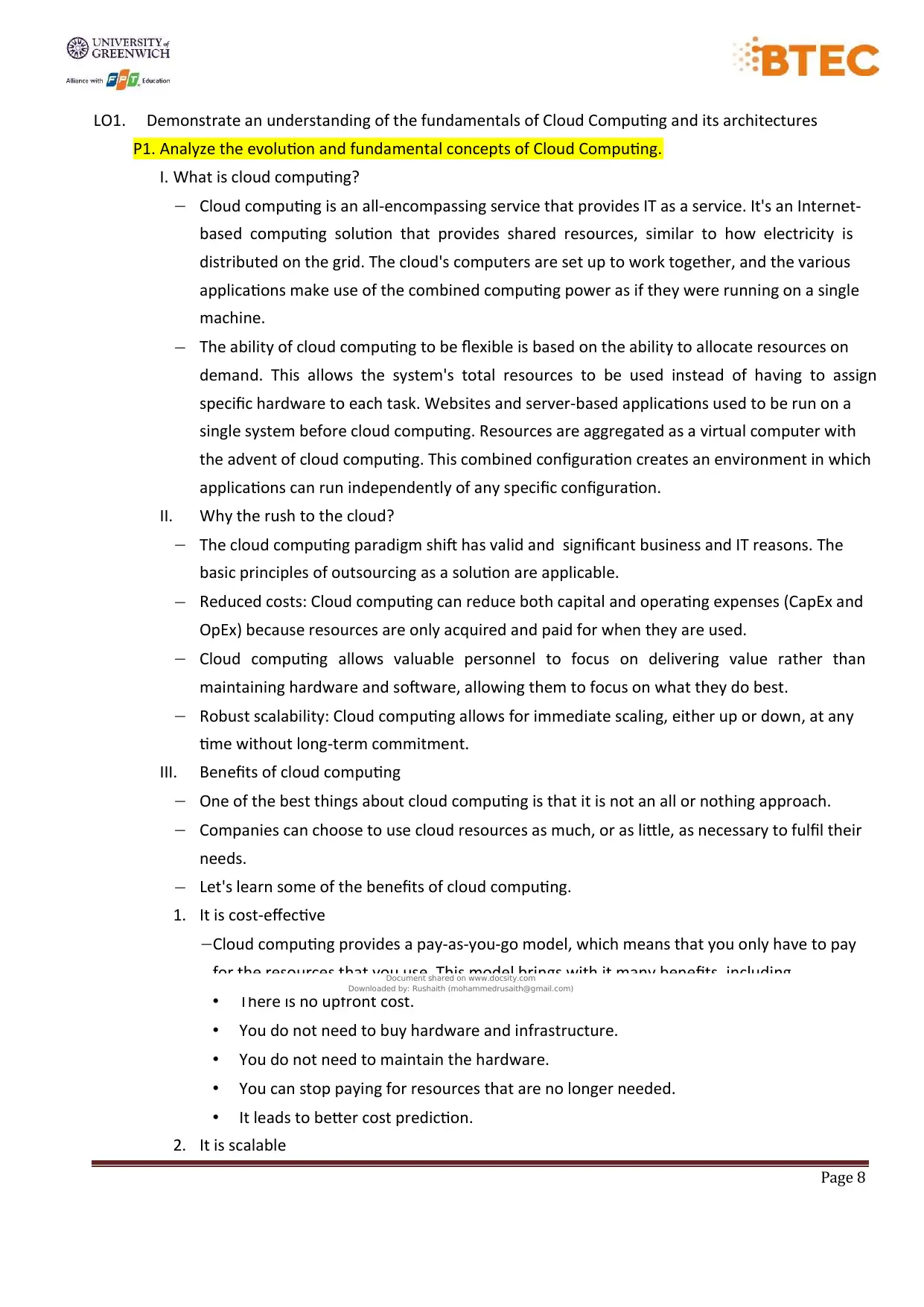
Page 8
LO1. Demonstrate an understanding of the fundamentals of Cloud Computing and its architectures
P1. Analyze the evolution and fundamental concepts of Cloud Computing.
I. What is cloud computing?
− Cloud computing is an all-encompassing service that provides IT as a service. It's an Internet-
based computing solution that provides shared resources, similar to how electricity is
distributed on the grid. The cloud's computers are set up to work together, and the various
applications make use of the combined computing power as if they were running on a single
machine.
− The ability of cloud computing to be flexible is based on the ability to allocate resources on
demand. This allows the system's total resources to be used instead of having to assign
specific hardware to each task. Websites and server-based applications used to be run on a
single system before cloud computing. Resources are aggregated as a virtual computer with
the advent of cloud computing. This combined configuration creates an environment in which
applications can run independently of any specific configuration.
II. Why the rush to the cloud?
− The cloud computing paradigm shift has valid and significant business and IT reasons. The
basic principles of outsourcing as a solution are applicable.
− Reduced costs: Cloud computing can reduce both capital and operating expenses (CapEx and
OpEx) because resources are only acquired and paid for when they are used.
− Cloud computing allows valuable personnel to focus on delivering value rather than
maintaining hardware and software, allowing them to focus on what they do best.
− Robust scalability: Cloud computing allows for immediate scaling, either up or down, at any
time without long-term commitment.
III. Benefits of cloud computing
− One of the best things about cloud computing is that it is not an all or nothing approach.
− Companies can choose to use cloud resources as much, or as little, as necessary to fulfil their
needs.
− Let's learn some of the benefits of cloud computing.
1. It is cost-effective
−Cloud computing provides a pay-as-you-go model, which means that you only have to pay
for the resources that you use. This model brings with it many benefits, including.
• There is no upfront cost.
• You do not need to buy hardware and infrastructure.
• You do not need to maintain the hardware.
• You can stop paying for resources that are no longer needed.
• It leads to better cost prediction.
2. It is scalable
Document shared on www.docsity.com
Downloaded by: Rushaith (mohammedrusaith@gmail.com)
LO1. Demonstrate an understanding of the fundamentals of Cloud Computing and its architectures
P1. Analyze the evolution and fundamental concepts of Cloud Computing.
I. What is cloud computing?
− Cloud computing is an all-encompassing service that provides IT as a service. It's an Internet-
based computing solution that provides shared resources, similar to how electricity is
distributed on the grid. The cloud's computers are set up to work together, and the various
applications make use of the combined computing power as if they were running on a single
machine.
− The ability of cloud computing to be flexible is based on the ability to allocate resources on
demand. This allows the system's total resources to be used instead of having to assign
specific hardware to each task. Websites and server-based applications used to be run on a
single system before cloud computing. Resources are aggregated as a virtual computer with
the advent of cloud computing. This combined configuration creates an environment in which
applications can run independently of any specific configuration.
II. Why the rush to the cloud?
− The cloud computing paradigm shift has valid and significant business and IT reasons. The
basic principles of outsourcing as a solution are applicable.
− Reduced costs: Cloud computing can reduce both capital and operating expenses (CapEx and
OpEx) because resources are only acquired and paid for when they are used.
− Cloud computing allows valuable personnel to focus on delivering value rather than
maintaining hardware and software, allowing them to focus on what they do best.
− Robust scalability: Cloud computing allows for immediate scaling, either up or down, at any
time without long-term commitment.
III. Benefits of cloud computing
− One of the best things about cloud computing is that it is not an all or nothing approach.
− Companies can choose to use cloud resources as much, or as little, as necessary to fulfil their
needs.
− Let's learn some of the benefits of cloud computing.
1. It is cost-effective
−Cloud computing provides a pay-as-you-go model, which means that you only have to pay
for the resources that you use. This model brings with it many benefits, including.
• There is no upfront cost.
• You do not need to buy hardware and infrastructure.
• You do not need to maintain the hardware.
• You can stop paying for resources that are no longer needed.
• It leads to better cost prediction.
2. It is scalable
Document shared on www.docsity.com
Downloaded by: Rushaith (mohammedrusaith@gmail.com)
Paraphrase This Document
Need a fresh take? Get an instant paraphrase of this document with our AI Paraphraser
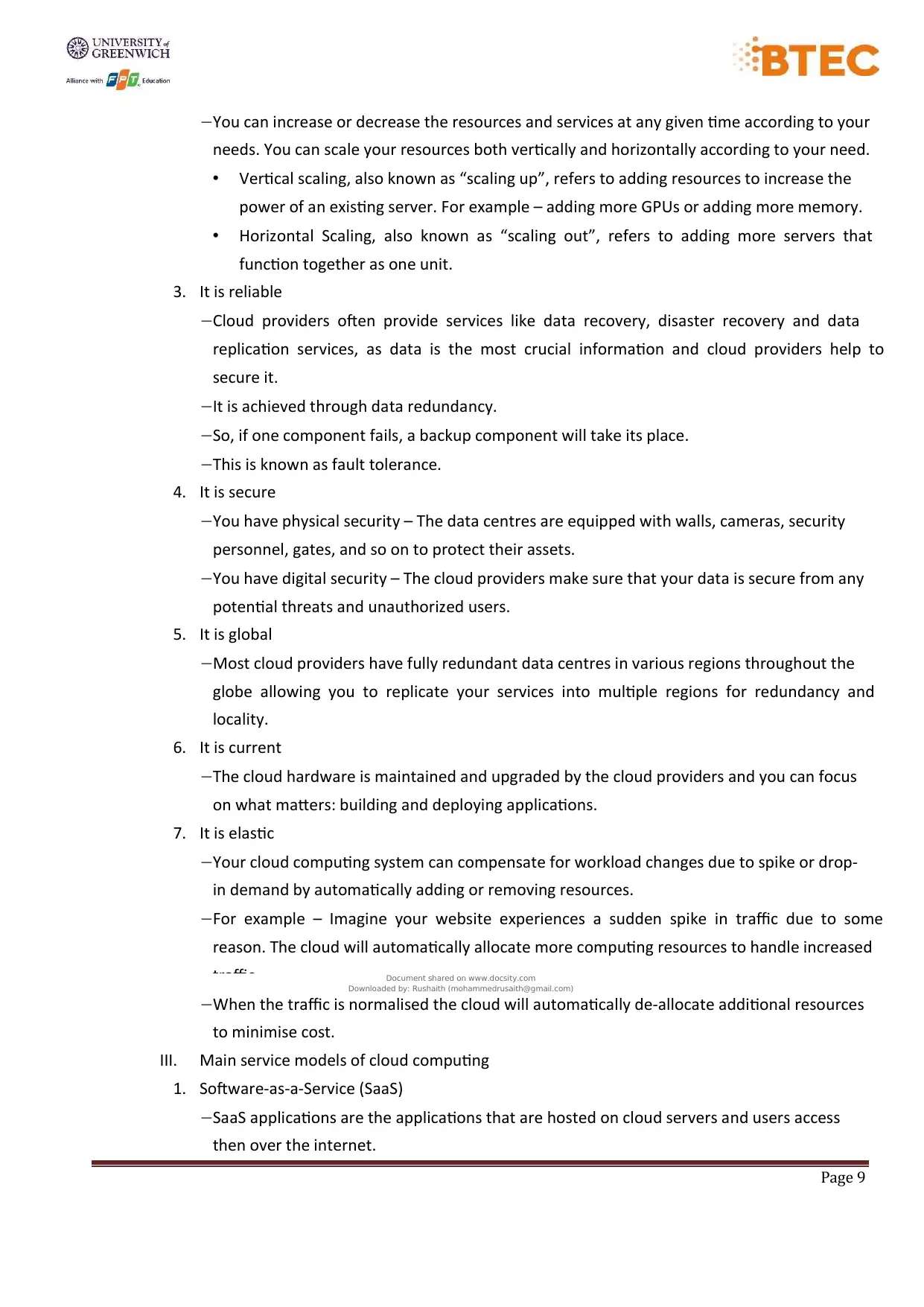
Page 9
−You can increase or decrease the resources and services at any given time according to your
needs. You can scale your resources both vertically and horizontally according to your need.
• Vertical scaling, also known as “scaling up”, refers to adding resources to increase the
power of an existing server. For example – adding more GPUs or adding more memory.
• Horizontal Scaling, also known as “scaling out”, refers to adding more servers that
function together as one unit.
3. It is reliable
−Cloud providers often provide services like data recovery, disaster recovery and data
replication services, as data is the most crucial information and cloud providers help to
secure it.
−It is achieved through data redundancy.
−So, if one component fails, a backup component will take its place.
−This is known as fault tolerance.
4. It is secure
−You have physical security – The data centres are equipped with walls, cameras, security
personnel, gates, and so on to protect their assets.
−You have digital security – The cloud providers make sure that your data is secure from any
potential threats and unauthorized users.
5. It is global
−Most cloud providers have fully redundant data centres in various regions throughout the
globe allowing you to replicate your services into multiple regions for redundancy and
locality.
6. It is current
−The cloud hardware is maintained and upgraded by the cloud providers and you can focus
on what matters: building and deploying applications.
7. It is elastic
−Your cloud computing system can compensate for workload changes due to spike or drop-
in demand by automatically adding or removing resources.
−For example – Imagine your website experiences a sudden spike in traffic due to some
reason. The cloud will automatically allocate more computing resources to handle increased
traffic.
−When the traffic is normalised the cloud will automatically de-allocate additional resources
to minimise cost.
III. Main service models of cloud computing
1. Software-as-a-Service (SaaS)
−SaaS applications are the applications that are hosted on cloud servers and users access
then over the internet.
Document shared on www.docsity.com
Downloaded by: Rushaith (mohammedrusaith@gmail.com)
−You can increase or decrease the resources and services at any given time according to your
needs. You can scale your resources both vertically and horizontally according to your need.
• Vertical scaling, also known as “scaling up”, refers to adding resources to increase the
power of an existing server. For example – adding more GPUs or adding more memory.
• Horizontal Scaling, also known as “scaling out”, refers to adding more servers that
function together as one unit.
3. It is reliable
−Cloud providers often provide services like data recovery, disaster recovery and data
replication services, as data is the most crucial information and cloud providers help to
secure it.
−It is achieved through data redundancy.
−So, if one component fails, a backup component will take its place.
−This is known as fault tolerance.
4. It is secure
−You have physical security – The data centres are equipped with walls, cameras, security
personnel, gates, and so on to protect their assets.
−You have digital security – The cloud providers make sure that your data is secure from any
potential threats and unauthorized users.
5. It is global
−Most cloud providers have fully redundant data centres in various regions throughout the
globe allowing you to replicate your services into multiple regions for redundancy and
locality.
6. It is current
−The cloud hardware is maintained and upgraded by the cloud providers and you can focus
on what matters: building and deploying applications.
7. It is elastic
−Your cloud computing system can compensate for workload changes due to spike or drop-
in demand by automatically adding or removing resources.
−For example – Imagine your website experiences a sudden spike in traffic due to some
reason. The cloud will automatically allocate more computing resources to handle increased
traffic.
−When the traffic is normalised the cloud will automatically de-allocate additional resources
to minimise cost.
III. Main service models of cloud computing
1. Software-as-a-Service (SaaS)
−SaaS applications are the applications that are hosted on cloud servers and users access
then over the internet.
Document shared on www.docsity.com
Downloaded by: Rushaith (mohammedrusaith@gmail.com)
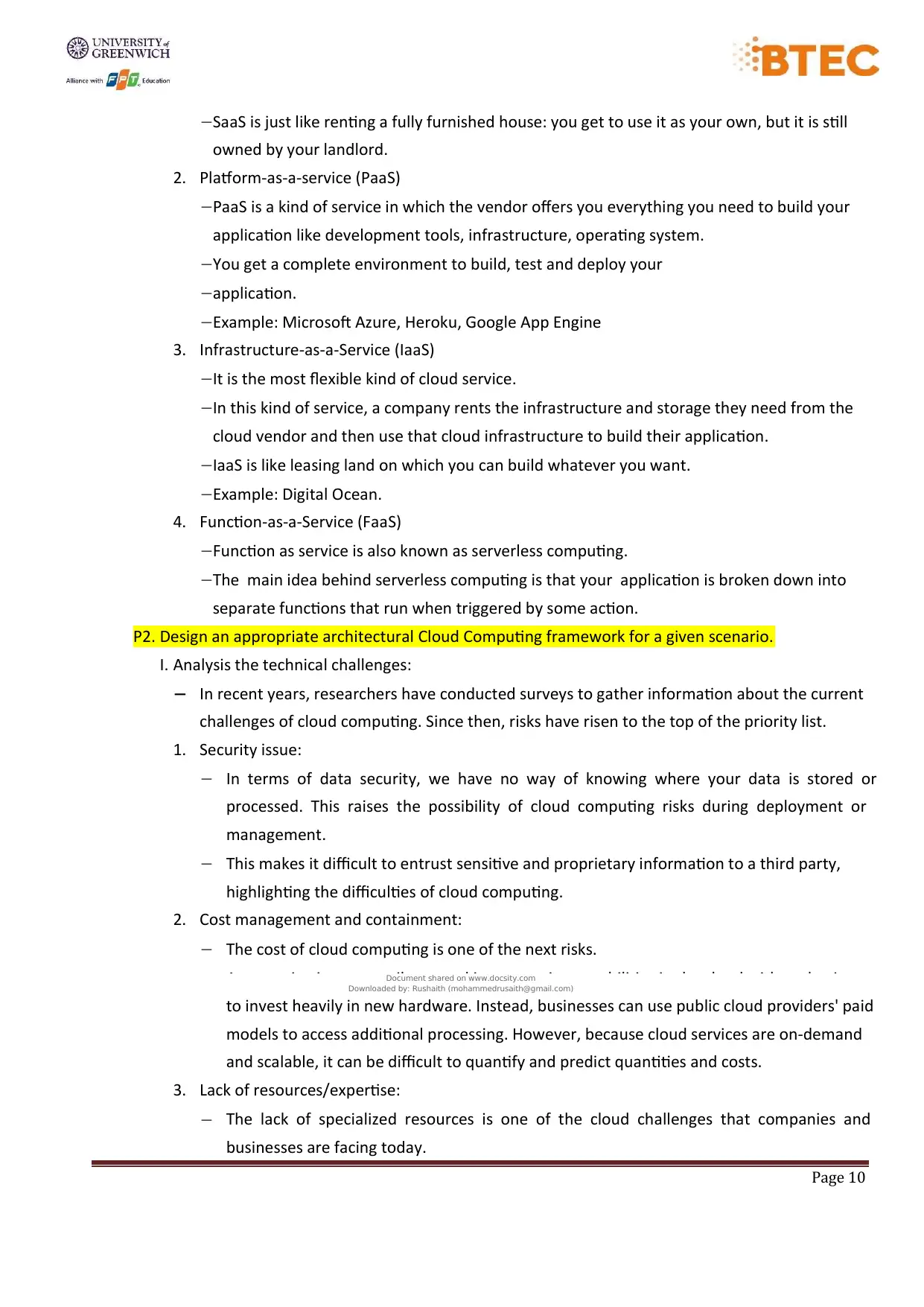
Page 10
−SaaS is just like renting a fully furnished house: you get to use it as your own, but it is still
owned by your landlord.
2. Platform-as-a-service (PaaS)
−PaaS is a kind of service in which the vendor offers you everything you need to build your
application like development tools, infrastructure, operating system.
−You get a complete environment to build, test and deploy your
−application.
−Example: Microsoft Azure, Heroku, Google App Engine
3. Infrastructure-as-a-Service (IaaS)
−It is the most flexible kind of cloud service.
−In this kind of service, a company rents the infrastructure and storage they need from the
cloud vendor and then use that cloud infrastructure to build their application.
−IaaS is like leasing land on which you can build whatever you want.
−Example: Digital Ocean.
4. Function-as-a-Service (FaaS)
−Function as service is also known as serverless computing.
−The main idea behind serverless computing is that your application is broken down into
separate functions that run when triggered by some action.
P2. Design an appropriate architectural Cloud Computing framework for a given scenario.
I. Analysis the technical challenges:
− In recent years, researchers have conducted surveys to gather information about the current
challenges of cloud computing. Since then, risks have risen to the top of the priority list.
1. Security issue:
− In terms of data security, we have no way of knowing where your data is stored or
processed. This raises the possibility of cloud computing risks during deployment or
management.
− This makes it difficult to entrust sensitive and proprietary information to a third party,
highlighting the difficulties of cloud computing.
2. Cost management and containment:
− The cost of cloud computing is one of the next risks.
− An organization can easily expand its processing capabilities in the cloud without having
to invest heavily in new hardware. Instead, businesses can use public cloud providers' paid
models to access additional processing. However, because cloud services are on-demand
and scalable, it can be difficult to quantify and predict quantities and costs.
3. Lack of resources/expertise:
− The lack of specialized resources is one of the cloud challenges that companies and
businesses are facing today.
Document shared on www.docsity.com
Downloaded by: Rushaith (mohammedrusaith@gmail.com)
−SaaS is just like renting a fully furnished house: you get to use it as your own, but it is still
owned by your landlord.
2. Platform-as-a-service (PaaS)
−PaaS is a kind of service in which the vendor offers you everything you need to build your
application like development tools, infrastructure, operating system.
−You get a complete environment to build, test and deploy your
−application.
−Example: Microsoft Azure, Heroku, Google App Engine
3. Infrastructure-as-a-Service (IaaS)
−It is the most flexible kind of cloud service.
−In this kind of service, a company rents the infrastructure and storage they need from the
cloud vendor and then use that cloud infrastructure to build their application.
−IaaS is like leasing land on which you can build whatever you want.
−Example: Digital Ocean.
4. Function-as-a-Service (FaaS)
−Function as service is also known as serverless computing.
−The main idea behind serverless computing is that your application is broken down into
separate functions that run when triggered by some action.
P2. Design an appropriate architectural Cloud Computing framework for a given scenario.
I. Analysis the technical challenges:
− In recent years, researchers have conducted surveys to gather information about the current
challenges of cloud computing. Since then, risks have risen to the top of the priority list.
1. Security issue:
− In terms of data security, we have no way of knowing where your data is stored or
processed. This raises the possibility of cloud computing risks during deployment or
management.
− This makes it difficult to entrust sensitive and proprietary information to a third party,
highlighting the difficulties of cloud computing.
2. Cost management and containment:
− The cost of cloud computing is one of the next risks.
− An organization can easily expand its processing capabilities in the cloud without having
to invest heavily in new hardware. Instead, businesses can use public cloud providers' paid
models to access additional processing. However, because cloud services are on-demand
and scalable, it can be difficult to quantify and predict quantities and costs.
3. Lack of resources/expertise:
− The lack of specialized resources is one of the cloud challenges that companies and
businesses are facing today.
Document shared on www.docsity.com
Downloaded by: Rushaith (mohammedrusaith@gmail.com)
⊘ This is a preview!⊘
Do you want full access?
Subscribe today to unlock all pages.

Trusted by 1+ million students worldwide
1 out of 39
Related Documents
Your All-in-One AI-Powered Toolkit for Academic Success.
+13062052269
info@desklib.com
Available 24*7 on WhatsApp / Email
![[object Object]](/_next/static/media/star-bottom.7253800d.svg)
Unlock your academic potential
Copyright © 2020–2025 A2Z Services. All Rights Reserved. Developed and managed by ZUCOL.





